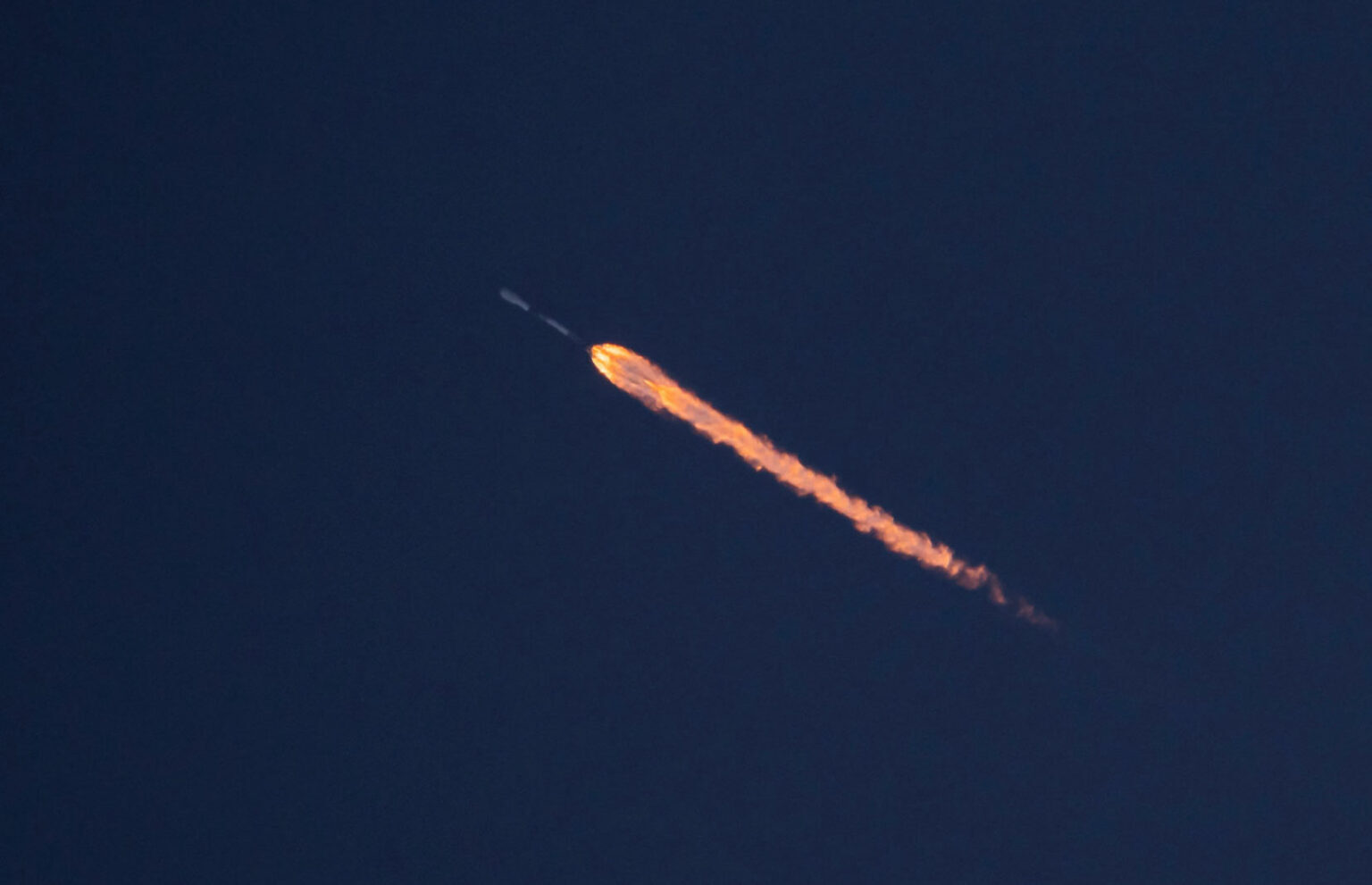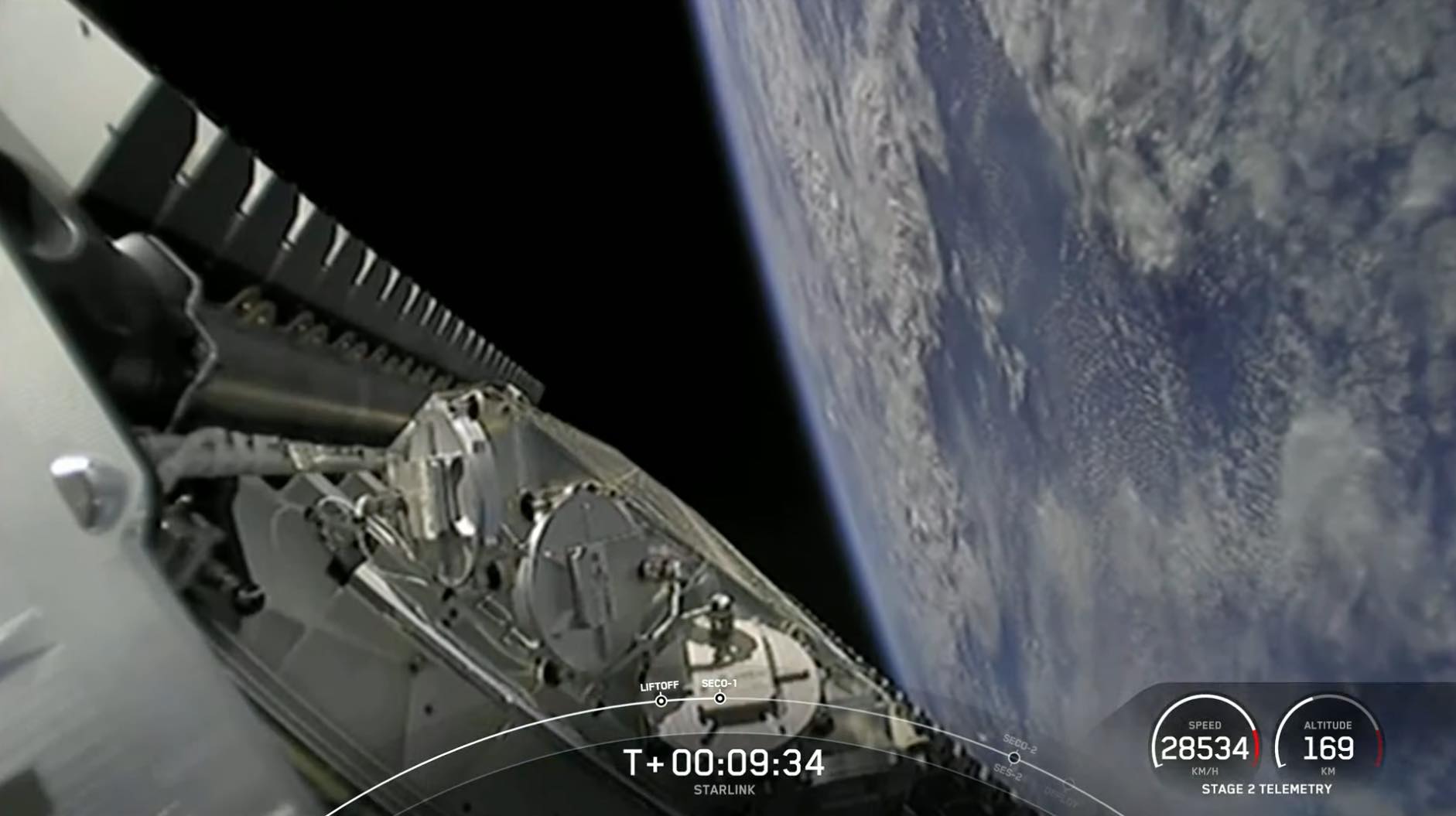12.07.2022

SpaceX launched the 50th dedicated mission for the Starlink internet network Sunday from California’s Central Coast, deploying 46 broadband relay nodes to begin populating a new polar-orbiting “shell” to fill in gaps in the satellite constellation.
The 46 Starlink satellites lifted off from foggy Vandenberg Space Force Base, about 140 miles (225 kilometers) northwest of Los Angeles, on top of a Falcon 9 rocket. The kerosene-fueled launcher took off from Space Launch Complex 4-East at 6:39:40 p.m. EDT Sunday (9:39:40 p.m.; 0139:40 GMT Monday).
Heading south from the military-owned spaceport, the Falcon 9 climbed through a marine cloud layer and accelerated through the sound barrier in about a minute. The first stage shut down its nine Merlin engines and separated from the Falcon 9’s upper stage, which ignited a single engine to continue the flight into orbit.
The booster returned to Earth for a controlled, propulsive landing on a drone ship positioned a few hundred miles south of Vandenberg in the Pacific Ocean. The booster — known as tail number B1063 in SpaceX’s reusable rocket fleet — completed its sixth flight to space Sunday.
The upper stage lit its engine for a brief second burn before releasing the mission’s 46 payloads more than an hour after liftoff.
The 46 satellites launched into a polar orbit to join some 2,500 Starlink spacecraft already in space. With Sunday’s mission, SpaceX has launched 2,805 Starlink satellites to date, including prototypes and spacecraft already removed from service.
The launch Sunday marked the 50th SpaceX mission with a primary task of hauling satellites into orbit for the Starlink network. In all, SpaceX has launched Starlink satellites or prototypes on 53 Falcon 9 flights, including three launches that included Starlink spacecraft as secondary or rideshare payloads.
But the new satellites deployed Sunday were the first to fly on a dedicated Starlink launch to polar orbit, beginning the construction of a new layer in the Starlink fleet.
Previous Starlink missions have launched into orbits inclined to the equator at angles of 53.0, 53.2, and 70 degrees. The network’s architecture also includes two other layers in orbits inclined 97.6 degrees to the equator to provide continuous global internet coverage.
One of those polar orbit “shells,” known as Group 3, was the target for Sunday night’s mission. The polar-orbiting satellites will extend Starlink coverage over the poles and help fill gaps in the rest of the constellation.
SpaceX began deploying Starlink satellites in 2019 and finished filling the shell at 53.0 degrees inclination, called Group 1, with 1,584 active satellites with a launch in May 2021. In September 2021, SpaceX launched the first batch of 51 Starlink satellites into a 70-degree inclination orbit on a Falcon 9 rocket from Vandenberg. That orbital shell, which hasn’t had any more launches since last September, will eventually contain 720 satellites.
SpaceX’s first launch into Group 4 of the Starlink network, at 53.2 degrees inclination, occurred in November 2021. SpaceX is now more than halfway complete with populating the 53.2 degree inclination shell, which will eventually number 1,584 satellites, the same number as Group 1.
The other Starlink shells — Groups 3 and 5 with 348 and 172 satellites each — are positioned in polar orbit at an inclination of 97.6 degrees. Sunday’s launch was designated Starlink 3-1.
All of the first-generation Starlink satellites will fly at altitudes between 335 and 354 miles (540-570 kilometers).
SpaceX has regulatory approval from the Federal Communications Commission for approximately 12,000 Starlink satellites. The company’s initial focus is on launching 4,400 satellites on a series of Falcon 9 rocket flights. SpaceX’s next-generation launcher, a giant rocket called the Starship, will eventually be tasked with launching hundreds of Starlink satellites on a single mission.
The Starlink satellites each weigh more than a quarter-ton, and are built on SpaceX’s Starlink assembly line in Redmond, Washington. The spacecraft are fitted with laser inter-satellite links to facilitate data transfers in orbit, without needing to relay signals through ground stations, which come with geographical, and sometimes political, constraints. Laser crosslinks can also reduce latency in the Starlink network because signals need to travel a shorter distance.
On Sunday’s mission, the Falcon 9 rocket targeted deployment of the 46 Starlink satellites into a near-circular orbit between 191 and 199 miles (308-by-320 kilometers) above Earth.
After separating from the Falcon 9, the Starlink satellites were expected to disperse and extend solar panels to begin generating electricity to recharge their batteries. The satellites will go through an automated checkout and activation sequence, then use krypton-fueled ion thrusters to raise their altitude to 348 miles (560 kilometers), where they will enter operational service in the Starlink network.

SpaceX said in May it has more than 400,000 subscribers for the Starlink internet service, which is designed to eventually provide high-speed, low-latency connectivity anywhere in the world.
The company won approval from the Federal Communications Commission last month to begin offering Starlink connectivity to mobile customers. So far, Starlink services have focused on fixed customers, such as homes, businesses, and schools.
SpaceX announced Thursday its will offer Starlink internet for customers on boats, yachts, oil rigs, and other users in the maritime market. Several airlines have tested or agreed to use Starlink connectivity on aircraft to provide in-flight WiFi for passengers.
The launch Sunday was the 29th flight of a SpaceX Falcon 9 rocket this year.
SpaceX’s next mission is scheduled to take off Thursday night from NASA’s Kennedy Space Center in Florida. A Falcon 9 rocket will launch a Dragon cargo ship on a commercial resupply mission to the International Space Station.
Quelle: SN
